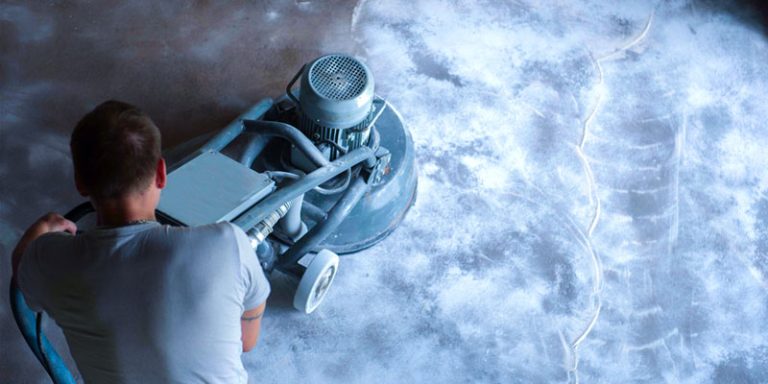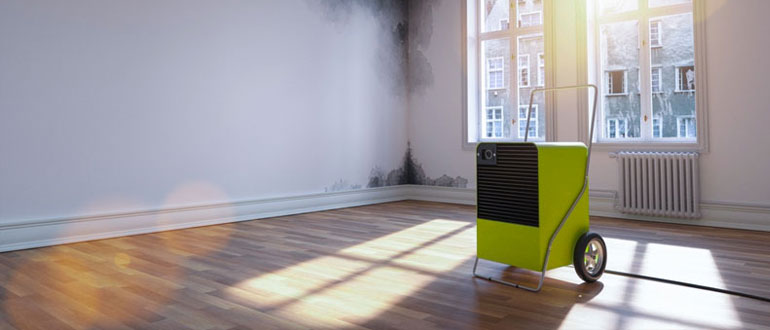Concrete floors are durable and suitable for many homes and businesses. But It can become dirty and unattractive if not correctly maintained. Not only is a clean floor more visually appealing, but it can also help to improve the air quality and overall hygiene of a room. Let’s dive into how to clean concrete floors with our comprehensive guide.
Cleaning concrete floors(Tile floors) can seem painful, but you can easily accomplish it with the right tools and supplies. Choosing the right cleaner for the job is essential, as using the wrong cleaner can damage the concrete or leave behind a residue. Following the steps recap in this article, you can effectively remove dirt, stains, and other debris from your concrete floors, leaving them fresh and clean.
Assessing the Condition of the Floor
Assessing the condition of the floor is an essential step in the process of cleaning concrete floors. Before beginning the cleaning process, it is necessary to identify any cracks, stains, or other damage that may require special treatment. This can help ensure that the cleaning process is as effective as possible and that any damaged areas are adequately addressed.
To assess the condition of the floor, start by taking a thorough look at the surface and identifying any areas that may require extra attention. This may include stains from spills or other sources, cracks or chips in the concrete, or other types of damage. Once you have identified any areas of concern, you can determine the best action for addressing them as part of the cleaning process.
Gathering Supplies to Clean Concrete Floors
Gathering the necessary supplies is an essential step in cleaning concrete floors. Some of the supplies you will need include:
- Broom and dustpan: These will be used to sweep up any loose debris or dirt on the floor before starting the cleaning process.
- Mop and bucket: A mop and bucket will be necessary for applying cleaning solution and rinsing the floor.
- Cleaning solution: Several types of cleaning solutions can be used on concrete floors, including pH-neutral, oil-based, and enzymatic cleaners. Choose a cleaning solution appropriate for your specific needs and the condition of the floor.
- Scrub brush: A scrub brush may be necessary for tackling stubborn stains or scrubbing the floor in filthy areas.
- Protective eyewear and gloves: Wearing protective eyewear and gloves can help protect you from any chemicals in the cleaning solution and keep you safe during the cleaning process.
- Other supplies: Depending on the specific needs of your floor and the cleaning process, you may need additional supplies such as a power washer, a pressure washer, or a steam cleaner.
Preparing the Area to Clean Concrete Floors
There are several critical steps involved in preparing the floor for Cleaning:
- Remove any loose debris: Before starting the cleaning process, removing any loose debris from the floor is crucial. This can be done using a broom and dustpan or a vacuum cleaner.
- Protect adjacent surfaces: It is necessary to protect adjacent surfaces, such as baseboards, walls, and other surfaces prone to damage. This can be done using protective coverings or to avoid splashing or overspray when applying the cleaning solution.
- Test the cleaning solution: Before using any cleaning solution on a concrete floor, it is a good idea to test a small, inconspicuous area to ensure the answer will not cause any damage or discoloration. This is particularly important if the floor has been previously sealed or if any stains or other areas of concern may be sensitive to specific Cleaning solutions.
- Gather all necessary supplies: Ensure you have all the essential supplies before starting the cleaning process. This may include a broom and dustpan, a mop and bucket, a cleaning solution, a scrub brush, protective eyewear and gloves, and other necessary tools or equipment.
- Pre-treat any stains or heavily soiled areas: If you see any stains or dirty spots on your floor(remove wax from), you may need to clean them first with a special cleaner or scrub them extra hard before you begin your regular cleaning routine. This can help ensure that these areas are thoroughly cleaned and that the cleaning process is as effective as possible.
To Clean Concrete Floors with Effective Ways
Cleaning the floor is a crucial step in maintaining concrete floors. There are several vital steps involved in cleaning a concrete foundation:
- Apply the cleaning solution: Using a mop or a cleaning tool such as a power washer or pressure washer, apply the cleaning solution to the floor. Be sure to follow the instructions on the cleaning solution’s label and take care not to oversaturate the floor, as this can cause the cleaning solution to take longer to dry and may also leave behind a sticky residue.
- Allow the cleaning solution to dwell: Depending on the type of cleaning solution used and the floor condition, staying for a certain amount of time may be necessary before rinsing. This can help ensure the cleaning solution has time to penetrate and lift any dirt or stains from the floor’s surface.
- Scrub stubborn stains or heavily soiled areas: If there are any stubborn stains or heavily soiled areas on the floor, it may be necessary to scrub these areas with a scrub brush or other cleaning tool to ensure thorough Cleaning.
- Rinse the floor: After the cleaning solution has worked, it is essential to rinse the floor thoroughly to remove any remaining dirt or cleaning solution. This can be done using a mop, clean water, a power washer, or a pressure washer.
- Dry the floor: After the foundation has been rinsed, it is essential to allow it to dry completely. This can help prevent the formation of mold or mildew and can also help prevent the construction of a sticky residue. Use a dry mop or towels to help absorb any remaining moisture.
Drying and Protecting to Clean Concrete Floors
Drying and protecting the floor are essential steps in maintaining concrete floors. Here are some critical considerations for drying and protecting concrete floors:
- Allow the floor to dry completely: After the foundation has been cleaned and rinsed, it is essential to dry completely. This can help prevent the formation of mold or mildew and can also help prevent the construction of a sticky residue. Use a dry mop or towels to help absorb any remaining moisture.
- Consider using fans or dehumidifiers: If your floor takes a long time to dry or the humidity is high, use a fan or dehumidifier to speed up the drying process. It can help dry things out faster.
- Apply a sealer or wax: Depending on the specific needs of your floor, consider applying a sealer or wax to protect the surface from stains and other types of damage. This can help extend the floor’s lifespan and keep it looking its best.
- Regularly sweep or vacuum the floor: To keep the floor clean and well-maintained, it is essential to periodically sweep or vacuum the surface to remove any loose debris or dirt. This can help prevent stains and other types of damage and can also help extend the lifespan of the floor.
- Spot clean as needed: If spills or stains occur, cleaning them up as soon as possible is essential to prevent them from becoming embedded in the floor’s surface. Use a cleaning solution, a scrub brush, or other cleaning tools to tackle stubborn stains or heavily soiled areas.
How to Clean the Indoor Cement Floor?
We recommend using pH-neutral floor cleaners or detergents to fill a large bucket with water. Use about one gallon (3.8 liters) of warm water. Stir in one-eighth to one-quarter cup (30 to 60 ml) of mild soap or pH-neutral cleaner (or the amount recommended by the manufacturer). Dunk a clean mop into the cleaning solution.
Also, you can use some good cleaners like Castile soap, liquid dish detergent, stone cleaners, and mild floor cleaners. Mix a solution, apply to the floor with a wet mop, then rinse with a mop dipped in clean water. Apply a Sealer To make your concrete floors resistant to future stains, apply a concrete sealant.
Advises dust mop or vacuum the floors to remove surface grit and soil that can scratch the painted finish. Mix a Cleaning Solution and Mop. After removing dust, mix a cleaning solution of warm water and an all-purpose cleaner like Whole Foods Market 365 All-Purpose Cleaner. Use a microfiber mop that is only slightly damp with the cleaning solution.
Scrubbing certain concrete stains with vinegar is an excellent and eco-friendly way to clean concrete. Vinegar is beneficial for removing rust stains, although it might not work for all types of colors. A natural, all-purpose cleaner, white vinegar, is one of the best ways to clean concrete, especially if your floor has stubborn stains caused by mildew or grease. Mix 3 cups of warm water with a cup of vinegar to make a DIY concrete cleaner.
The Most Common FAQs
Q: What is the best way to remove dirt and debris from a concrete floor?
A: A broom or vacuum can effectively remove loose dirt and debris. A pressure washer or scrub brush may be necessary for more stubborn dirt and stains.
Q: Can I use any cleaner on a concrete floor?
A: Choosing a cleaner appropriate for the type of stain and concrete is essential. Using the wrong cleaner can damage the floor or leave behind a residue.
Q: How do I remove oil stains from a concrete floor?
A: Oil stains can be difficult to remove, but a pressure washer or cleaner designed for oil stains can be effective. It may also be necessary to scrub the stain with a brush.
Q: Can I use a steam mop on a concrete floor?
A: Using a steam mop on a concrete floor is generally not recommended because heat and moisture can damage the surface. A regular wet mop or a hose may be a better option.
Q: How do I remove rust stains from a concrete floor?
A: Remove rust stains with a cleaner specifically designed for rust or with a lemon juice and salt mixture. You may also scrub the paint with a scrub brush.
Q: How do I remove paint from a concrete floor?
A: You can often remove fresh paint with a scraper or putty knife. For dried paint, a lacquer thinner or acetone can be effective.
Q: Can I use a carpet cleaner on a concrete floor?
A: A carpet cleaner on a concrete floor is generally not recommended, as high pressure and heat can damage the surface.
Q: How do I prevent dirt and stains from accumulating on my concrete floor?
A: It is helpful to use mats at entrances and high-traffic areas and to sweep or vacuum the floor regularly. Sealing the concrete can also help to protect it from stains.
Conclusion
In conclusion, you may clean your concrete floors efficiently. To ensure an effective way to clean your concrete floors and make hygiene of a space. You can keep your concrete floors looking their best by gathering the necessary supplies, removing debris or dirt.
Furthermore, Apply the appropriate cleaner, rinse and dry the floor, and follow up with maintenance and prevention measures. You can quickly transform your concrete floors from dull and dirty to clean and polished with a little effort.



